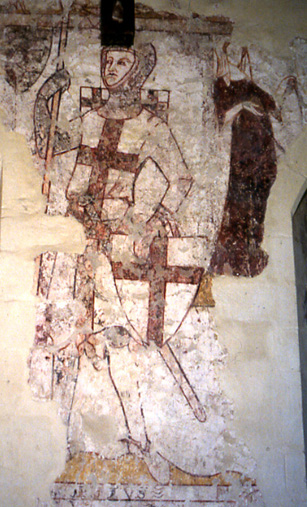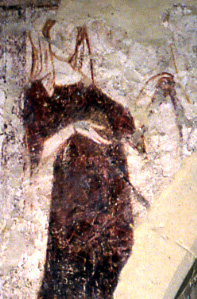Little Kimble, Buckinghamshire (Oxford) C.14
St George, with the Princess

This is the church of All Saints (there is also a church dedicated to St Nicholas in Little Kimble), and it still retains many of the paintings of saints which would once have covered the walls. All are fine paintings by an anonymous but very accomplished 14th-century artist.
The elegantly posed saint, standing with shield and lance, rather than on horseback, wears the chainmail armour of the earlier fourteenth century. His white surcoat and the shield in his left hand bear his red cross, and this is repeated in the square ailletes he wears on his shoulders. Beside his right hand is another shield, very obscure now, but once bearing the three lions passant gardant of England. Below the figure, in Lombardic capitals, is an identifying inscription reading GEORGIUS.

There is no sign of the Dragon, although this might once have been shown somewhere near the saint’s right foot. The Princess, however, saved by George from becoming a propitiatory sacrifice to the Dragon, is painted at the upper right. Tristram described her as “holding in her right hand a ball from which hangs in festoon a long thread, its end held in her other hand.”¹. The enlarged detail shown at the right seems to bear this out, but it is much harder to be sure what the details of the ‘ball and thread’ imply. Spinning is an obvious possibility, although the posture seems wrong for that, but in any case, according to the story (more details of which are on the page for St George at Broughton), the princess, when all had ended happily, led the Dragon by her girdle.
This is what is happening here, I think, and there may even be an element of deliberate mockery in the princess’s triumphantly graceful pose, grasping the ‘reins’ of her vanquished enemy.
Of the other paintings in the church St Francis preaching to the birds is here, along with a painting of a man holding a mysterious painted Triptych. A Burial of St Catherine and other paintings will be here soon. All are, like this painting, skilfully executed, with a similarly acute eye for the telling details of narrative. Three hundred years after they were made, All Saints would become the parish church of the Buckinghamshire landowner John Hampden, who famously defied King Charles 1 over Ship Money.
Website for All Saints, Little Kimble
¹ Tristram III, p.188